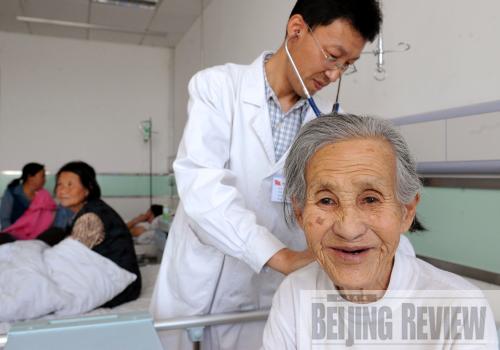The more than 30 years after the reform and opening-up policy was implemented has been a period of progressive growth, when citizens enjoyed the fastest increase of income and benefits. Per-capita disposable income of urban residents jumped from 343 yuan ($50) in 1978 to 15,781 yuan ($2,310) in 2008. The per-capita net income of farmers grew to 4,761 yuan ($697) in 2008 from 134 yuan ($19) in 1978. The per-capita housing space and household wealth have also witnessed a significant growth with remarkable improvements in living conditions. The shortage of goods that plagued the country before the launch of the reform and opening-up has finally been resolved.
 |
|
FREE MEDICARE: Mao Yuye, 82, receives a health check before she leaves the hospital in Shenmu County, Shaanxi Province. Mao suffered pleural effusion and only spent 40 yuan ($5.86) for one-month of treatment in the hospital, while the government covered the rest of the 8,496 yuan ($1,243) (TAO MING)
|
The Engel Coefficient—the proportion of income spent on food—of rural households dropped to 43.1 percent in 2007 from as high as 67.7 percent in 1978. The Engel Coefficient of urban households fell to 36.3 percent in 2007 from 57.5 percent in 1978. The proportion of money spent on culture, education, entertainment and services per capita in rural and urban households rose to 9.5 percent and 13.3 percent, respectively, in 2007 and went up from 5.1 percent and 8.4 percent respectively in 1980.
- Changing social structure
China's social structure has seen tremendous changes, along with the progress of industrialization and urbanization, due to the enormous benefits from the reform and opening-up policy. Its national strength has increased considerably, turning China to an emerging industrial power from the predominantly agrarian country it once was.
At the same time, China's industrial structure has changed significantly. The industrial transformation can be divided into two phases: from 1949 to 1978 and from 1978 to the present.
The first phase witnessed the proportion of primary, secondary and tertiary industries change from a ratio of 53:18:29 to 31:45:24. During this phase, the secondary industry experienced rapid expansion and became the basic industry propping up the national economy. Agriculture's contribution to economic growth dropped to some extent, but still played a leading role. Compared with the aforementioned two industries, the growth of the service industry was relatively slow.

During the second phase, the proportion of the industries changed to 11.3:48.6:40.1. The service industry began to soar, while the growth of the secondary industry remained steady. Agriculture's contribution to the national economy, on the other hand, has been falling rapidly. The vast changes in the industrial structure show that the Chinese economy has entered the middle phase of industrialization.
In 1949, the urban population of China was only 57 million, accounting for 10.6 percent of the country's total, 3 percentage points lower than the world average in 1900, suggesting China was a typical agrarian country. From 1949 to 1978, the urbanization level rose to 19.7 percent. After the reform and opening-up policy was adopted, urbanization accelerated to 45.7 percent in 2008. The number of cities in China has reached 655—462 more than in 1978. About 118 of those cities have a population of more than 1 million. Chinese cities have seen their economic strength grow rapidly, with cities administratively ranked at and above the prefecture level creating 63 percent of the national GDP.